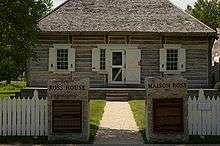Ross House Museum
The Ross House Museum is a museum located in Winnipeg, Manitoba, Canada, housed in a log house (constructed 1852–55) that was designated a Winnipeg Landmark Heritage Structure in 1980.[1]
 | |

| |
| Established | 1854 (Post Office) 1947 (Museum) 1980 (Heritage site) |
|---|---|
| Location | 140 Meade Street N Winnipeg, Manitoba, R2W 3K4 Canada |
| Coordinates | 49.9070°N 97.1297°W |
| Type | Historic house museum |
| Curator | Eric Napier Strong |
| Public transit access | 45 Talbot |
| Website | www |
| Official name | Ross House Museum Winnipeg Landmark Heritage Structure |
| Designated | 1980 |
History
Originally standing on the bank of the Red River at the foot of what is now Market Avenue, the building became the first post office in Western Canada with the appointment of William Ross (Metis) as postmaster by the Council of Assiniboia in 1855. The building was saved from demolition in 1947 by the Manitoba Historical Society and moved to Higgins Ave across from the C.P.R. station.[2] There it was restored, with the land and house featuring artifacts, monuments and markers relevant to the early history of Manitoba. In 1984 the house was once more moved, this time to its present location in Joe Zuken Heritage Park in Point Douglas.
Metis Postmaster William Ross was the second son of Alexander and Sarah Ross. He was born in the Columbia River area. When his father retired from the fur trade and he brought his wife and their children from British Columbia to Red River just after the amalgamation of the North West Company and the Hudson's Bay Company. William married Jemima McKenzie the daughter of the well-known fur trader, Roderick McKenzie. William was appointed Sheriff of Assiniboia in 1851 (after his father resigned from the post) and was appointed Post Master for Red River in 1855 by the Council of Assiniboia. He operated the postal service from his house near the Red River at the foot of Market Avenue. This house was built in 1851-52 by his sister Margaret's husband, Hugh Matteson.[3]
William donated the land for Winnipeg City Hall during the 1870s. The donation was conditional upon city hall not being moved. Other portions of the Ross estate were expropriated for Market Square and the Winnipeg Transfer Railway.[4]
Soil samples were conducted in 2011 at the site. Results were positive for "significant toxins in the soil".[5]
Ross House Museum received more than $31,000 (2015) in funding from the City of Winnipeg. However, under Mayor Bowman, these and other grants to civic museums were being reviewed.[6]
In 2018 operation of the Museum was given to the Seven Oaks House Museum from the Manitoba Historical Society. The MHS had cited lack of government funding and security issues as reasons for handing over responsibilities to another organization.[7][8]
Affiliations
The museum is affiliated with CMA, CHIN, and the Virtual Museum of Canada.
See also
References
- Ross House Museum. Canadian Register of Historic Places. Retrieved 2010-1-29.
- Grover, Sheila (1981). "Ross House, A Manitoba Historical Society Museum". Manitoba History 2. Manitoba Historical Society. Retrieved 2012-1-29. Manitoba Historical Society.
- Barkwell, Lawrence. http://www.metismuseum.ca/media/document.php/12139.William%20Ross%20Sr%20(b.%201825).pdf
- Barkwell, Lawrence,. Op cit.
- Sanders, Carol (March 25, 2011). "Contamination fears haunt garden". Winnipeg Free Press. p. A13.
- Santin, Aldo (October 10, 2015). "No Fun: Funding cuts could hit Children's Museum hard". Winnipeg Free Press. p. B1.
- Caruk, Holly (May 23, 2018). "Ross House Museum saved from closure". CBC News Manitoba.
- Thorpe, Ryan (February 6, 2018). "Museum's future in jeopardy". Winnipeg Free Press. p. B1.